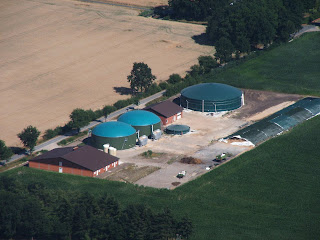The little sketch above shows the basic process involved. Farmers supply all of the raw materials, agricultural waste, energy crops and slurry, it all sounds yucky and smelly but its not as bad as it seems.
Probably the most important piece of plant in the process is the digestor itself and a cross section sketch of one is shown below:
What happens is that a mixture of all the yucky stuff is pumped into the bottom of the digestor which is really just a large concrete tank. The mixture is stirred or agitated in the mixing zone where it starts to break down and in the process of breaking down it gives off methane gas. Methane gas is the smell you smell when passing a local authority landfill site or when...well, I'll not be rude. Anyway, the methane gas is captured in the digestor and syphoned off to fuel a generator. The generator produces electricity which can then be fed into the grid. The benefits of capturing this methane which would otherwise be released into the athmosphere and lead to further greenhouse gas emmisions is obvious. As a greenhouse gas by the way, Methane is 25 times worse than Carbon Dioxide. Carbon Dioxide is of course produced in the generation process but as this process produces both electricity and heat which can be used to provide heating to local facillities, the benefits far outweigh the the carbon release.
So, what do these AD plants look like?
Below are some photos of plants I recently visted in Germany. The plant, storage facillities and associated building fit comfortably on a 1 Hectare site, (approx 2.5 Acres). Given this, in my opion, they are not much bigger than a reasonably sized farm yard with out buildings.
If you look at the second photo in this set of four, you will see a chap standing in front of a digestor tank, he is 6ft 4in. tall, so as you can see, the tanks are not terribly big. The last photo in the set of four, indciates the extent of one site. This site has three digestors, whereas I would be proposing only two for the size of the generator I would be using, (1 MegaWatt).
So what exactly is my proposal?
I hope to set up, along with local farmers and communities, an exclusive co-operative venture for the purposes of generating electricity. This venture will utilise Anaerobic Digestion and will be established on a phased basis:
Phase 1
This phase will consist of a “model” Anaerobic Digestion plant which will supply electricity to the national grid. It is envisaged that this will be a test bed for the future technical and business model.
Phase 2
Several more plants will be developed nationwide in suitable locations. Each plant will be identical in terms of size and output in order to reduce design fees and capital costs. These plants along will form the basis of a nationwide network of facilities supplying to the national grid.
Phase 3
In the medium term, a further 60 to 70 plants will be set up nationwide. At this point the venture will be in a position to become an electricity supply company and will then sell electricity to local communities in rural areas. At this point, in approximately five years from initial start-up, it is hoped that 500+ people would be employed directly in the company with countless other employment opportunities being made available to employees of our suppliers and contractors.
What are the benefits of Anaerobic Digestion?
- It is a proven technology that extracts energy in the form of biogas, (methane), from organic waste.
- It is a natural process of decomposition that takes place in the absence of oxygen and by which organic mater is broken down to its simpler chemical components.
- It can reduce Ireland’s green house gas emissions by up to 40%.
- Digestion of agricultural slurries and waste and high energy crops, yield a substance that has lower pollution potential and is more suitable than raw slurries as a fertiliser.
- Electricity generated from biogas displaces fossil fuel generated electricity and thus has a reduced environmental impact.
- The AD process can be used to turn residues from farming, food processing and other organic wastes into biogas. This biogas can be used to generate heat and/or electricity, fibre, which can be used as a soil conditioner and liquor, which can be used as a liquid fertiliser.
A gas fueled Generator
A hopper used to feed dry raw materials into Digestor. Mixing with wet materials takes place beneath.
Inside the Hopper
Typical electricity grid connection point










